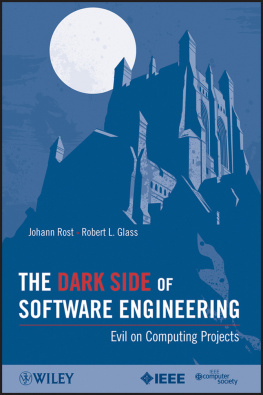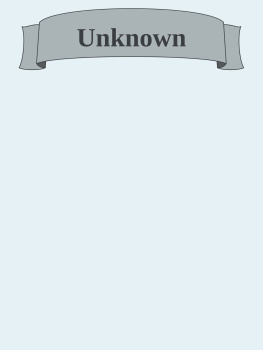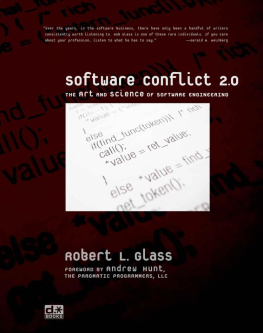Glass Robert L.Rost Johann. - The dark side of software engineering: evil on computing projects
Here you can read online Glass Robert L.Rost Johann. - The dark side of software engineering: evil on computing projects full text of the book (entire story) in english for free. Download pdf and epub, get meaning, cover and reviews about this ebook. year: 2011, publisher: John Wiley & Sons, Inc., genre: Romance novel. Description of the work, (preface) as well as reviews are available. Best literature library LitArk.com created for fans of good reading and offers a wide selection of genres:
Romance novel
Science fiction
Adventure
Detective
Science
History
Home and family
Prose
Art
Politics
Computer
Non-fiction
Religion
Business
Children
Humor
Choose a favorite category and find really read worthwhile books. Enjoy immersion in the world of imagination, feel the emotions of the characters or learn something new for yourself, make an fascinating discovery.
- Book:The dark side of software engineering: evil on computing projects
- Author:
- Publisher:John Wiley & Sons, Inc.
- Genre:
- Year:2011
- Rating:4 / 5
- Favourites:Add to favourites
- Your mark:
- 80
- 1
- 2
- 3
- 4
- 5
The dark side of software engineering: evil on computing projects: summary, description and annotation
We offer to read an annotation, description, summary or preface (depends on what the author of the book "The dark side of software engineering: evil on computing projects" wrote himself). If you haven't found the necessary information about the book — write in the comments, we will try to find it.
The dark side of software engineering: evil on computing projects — read online for free the complete book (whole text) full work
Below is the text of the book, divided by pages. System saving the place of the last page read, allows you to conveniently read the book "The dark side of software engineering: evil on computing projects" online for free, without having to search again every time where you left off. Put a bookmark, and you can go to the page where you finished reading at any time.
Font size:
Interval:
Bookmark:



Press Operating Committee
Chair
Linda Shafer
former Director, Software Quality Institute
The University of Texas at Austin
Editor-in-Chief
Alan Clements
Professor
University of Teesside
Board Members
Mark J. Christensen, Independent Consultant
James W. Cortada, IBM Institute for Business Value
Richard E. (Dick) Fairley, Founder and Principal Associate, Software Engineering Management Associates (SEMA)
Phillip Laplante, Professor of Software Engineering, Penn State University
Evan Butterfield, Director of Products and Services
Kate Guillemette, Product Development Editor, CS Press
IEEE Computer Society Publications
The world-renowned IEEE Computer Society publishes, promotes, and distributes a wide variety of authoritative computer science and engineering texts. These books are available from most retail outlets. Visit the CS Store at http://computer.org/store for a list of products.
IEEE Computer Society / Wiley Partnership
The IEEE Computer Society and Wiley partnership allows the CS Press authored book program to produce a number of exciting new titles in areas of computer science, computing and networking with a special focus on software engineering. IEEE Computer Society members continue to receive a 15% discount on these titles when purchased through Wiley or at wiley.com/ieeecs
To submit questions about the program or send proposals please e-mail kguillemette@computer.org or write to Books, IEEE Computer Society, 10662 Los Vaqueros Circle, Los Alamitos, CA 90720-1314. Telephone +1-714-816-2169.
Additional information regarding the Computer Society authored book program can also be accessed from our web site at http://computer.org/cspress.
Copyright 2011 by IEEE Computer Society. All rights reserved.
Published by John Wiley & Sons, Inc., Hoboken, New Jersey.
Published simultaneously in Canada.
No part of this publication may be reproduced, stored in a retrieval system, or transmitted in any form or by any means, electronic, mechanical, photocopying, recording, scanning, or otherwise, except as permitted under Section 107 or 108 of the 1976 United States Copyright Act, without either the prior written permission of the Publisher, or authorization through payment of the appropriate per-copy fee to the Copyright Clearance Center, Inc., 222 Rosewood Drive, Danvers, MA 01923, 978-750-8400, fax 978-646-8600, or on the web at www.copyright.com. Requests to the Publisher for permission should be addressed to the Permissions Department, John Wiley & Sons, Inc., 111 River Street, Hoboken, NJ 07030, (201) 748-6011, fax (201) 748-6008.
Limit of Liability/Disclaimer of Warranty: While the publisher and author have used their best efforts in preparing this book, they make no representations or warranties with respect to the accuracy or completeness of the contents of this book and specifically disclaim any implied warranties of merchantability or fitness for a particular purpose. No warranty may be created or extended by sales representatives or written sales materials. The advice and strategies contained herein may not be suitable for your situation. You should consult with a professional where appropriate. Neither the publisher nor author shall be liable for any loss of profit or any other commercial damages, including but not limited to special, incidental, consequential, or other damages.
For general information on our other products and services please contact our Customer Care Department within the U.S. at 877-762-2974, outside the U.S. at 317-572-3993 or fax 317-572-4002.
Wiley also publishes its books in a variety of electronic formats. Some content that appears in print, however, may not be available in electronic format.
Library of Congress Cataloging-in-Publication Data is available.
ISBN 978-0470-59717-0
ePDF: 978-0-470-90994-2
oBook: 978-0-470-90995-9
ePub: 978-0-470-92287-3
FOREWORD
Dr. Linda Rising
Robert Glass has always been one who boldly goes where the more cautious fear to tread. I have been a fan of his writing for, well, lets just say, a long time. I remember when he started telling the truth as he saw it about software development and was forced to change the names of the companies and products that he was discussinghe even changed his own name to conceal authorship of published accounts. I remember teaching a course on structured design (using the green book by Yourdon and Constantinethats how long ago that was!) and if I finished a class early, I would say to my students, You can go now or I can read another story by Robert Glass. No one ever left before the story was finished. Cornbelt Shakedown (from Glass and DeNim [1980]) was a favorite. Many of these stories are the kind of humor that leads you to wonder, Why am I laughing? To keep from crying?
Later, as I was working in the industry, I led a study group on Software Runaways (Glass 1997) and experienced the serious side of Robert Glass. Very little of the wry and witty here, but, instead, a lot of lessons for serious consideration.
Robert Glass, joined in this book with Johann Rost, is still at it. He continues to be (I cant resist) fearless! (The reference is to my own book, Manns and Rising [2005]). I dont know Johann except through his work on this book, which is excellent, and from what Ive been toldthat hes a German former IT consultant now living in beautiful Romania, the land of Transylvania, Dracula, and Ceau escu its no wonder the book has a dark side theme! This book is also full of stories about real projects at real companies. Names are named. The result is a compelling look at the dark side of computer programming. We are all hardwired to learn from stories, especially when we can identify with the protagonists.
escu its no wonder the book has a dark side theme! This book is also full of stories about real projects at real companies. Names are named. The result is a compelling look at the dark side of computer programming. We are all hardwired to learn from stories, especially when we can identify with the protagonists.
Hacking, espionage, sabotage, theft, whistle-blowing, subversion, disgruntled employees who want to get evenand, of course, the dance of deception. Weve all seen itwhere we know and they know , in fact, everyone knows but we all smile and keep dancing as long as we can. The authors cut in on this charade and force us to wake up and take stock.
Robert and Johann also include the results of their serious research. They have certainly done their homework. Theres an abundance of citations to back up their observations. The survey data on sabotage is fascinating!
This reporting is way out of the box; in fact, these authors are standing on the box and they share with us a good look at the terrainsomething most of us just dont take the time to do; we prefer to rush ahead and ignore the lessons of the past.
So, take a moment. We need a breather now and then. We need to step back and retrospect on the history of our industry and think about a better way of working within it. Robert Glass and Johann Rost are offering us a chance to do just that. Stop. Listen. Think. Is this the road that will serve us best for the next part of our journey?
REFERENCES
Glass, Robert and DeNim, Sue. The Second Coming: More Computing Projects Which Failed, Computing Trends, 1980.
Glass, Robert. Software Runaways: Monumental Software Disasters . Prentice-Hall, 1997.
Font size:
Interval:
Bookmark:
Similar books «The dark side of software engineering: evil on computing projects»
Look at similar books to The dark side of software engineering: evil on computing projects. We have selected literature similar in name and meaning in the hope of providing readers with more options to find new, interesting, not yet read works.
Discussion, reviews of the book The dark side of software engineering: evil on computing projects and just readers' own opinions. Leave your comments, write what you think about the work, its meaning or the main characters. Specify what exactly you liked and what you didn't like, and why you think so.










